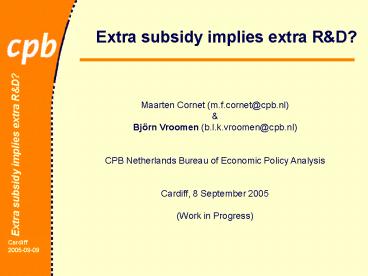Extra subsidy implies extra R PowerPoint PPT Presentation
1 / 18
Title: Extra subsidy implies extra R
1
Extra subsidy implies extra RD?
Maarten Cornet (m.f.cornet_at_cpb.nl) Björn
Vroomen (b.l.k.vroomen_at_cpb.nl) CPB Netherlands
Bureau of Economic Policy Analysis Cardiff, 8
September 2005 (Work in Progress)
2
Introduction
- Innovation important driver of economic growth
- Effectiveness of innovation support programmes in
general unclear - causality or correlation?
- Analysis of (change in) policy with social
experiment framework - We present two examples where causal relation can
and can not be identified
3
The WBSO
- WBSO Dutch RD tax credit programme
- Credit based on RD-employment (total RD wage
expenditures) - 40 tax credit for the first 68k, 13 for the
remaining - 2001 two additions to the programme
- additional support for new RD-firms
(technostarter) - extension of the first tax-credit bracket (
68k? 90k)
4
Data
- Data provided by
- Dutch Tax and Customs Administration
- SenterNovem (Ministry of Economic Affairs,
programme administrator) - Data provided on participants in the
WBSO-programme - total yearly RD wages
- firm characteristics (branch, turnover, total
wages) - period 1994-2003 (2000-2001 analysis)
- 28000 records
5
Technostarter programme
- RD wages expenditures till 90k 60 tax credit
instead of standard 40 - Firms have to be younger than 5 years
- Firms should not have obtained more than 2 years
of WBSO funding - ? max of three years of technostarter funding
6
Technostarter identification
7
Ideal case?
- Nearly ideal
- Difference in age may influence reaction of firms
- Difference in experience with the WBSO program
(that is, experience with RD) may influence
reaction of firms - Include control variables
- age and WBSO experience
- firm characteristics
8
Increase RD wage expenditures?
- Technostarter vs near-technostarter
- difference-in-difference estimator 18 (p0.00)
- first-difference estimator 14 (p0.00)
- Technostarter vs hidden technostarter
- FD-estimator 11 (p0.01)
- Effect of policy on RD wage expenditures is
estimated between 10 and 20
9
Value for money?
- Bang-for-the-Buck (BFTB) Ratio between extra RD
and extra public funding - Effect 10-20 BFTB 40-60
- 1 extra public funding implies 0.50 extra RD
wage costs, given an effect of 15 - Are the social benefits higher than the social
costs? - in general they are
10
Extension first tax-credit bracket
- Increase of 68k to 90k
- Category 1 (control group), firms below 68k
- no change, credit remains 40
- Category 2 (experimental group), firms between
68k and 90k - increase of 13 to 40
- Category 3 (Control group), firms above 90k
- no change, remains 40 13, however lump sum
subsidy
11
Methodological issues
- Firms in control group can also be influenced
by treatment - difference in effect is estimated
- Choice of group sizes may influence results
- Group membership is not constant over time
- ? No convincing causal relation!
- Lets ignore problems for now
12
Increase RD wage expenditures? (ignoring
methodological issues)
- Compare 50k-68k with 68k-90k
- DD-estimator 2.6 increase (p0.01)
- FD-estimator ?
- Compare 90k-120k with 68k-90k
- DD-estimator 2.9 increase (p0.01)
- FD-estimator ?
- DD , FD ? ? group composition effect?
13
Value for money?
- Extra funding firms above 90k is quite costly
- lump sum ( 6000) ? minimal effect expected
- in 2000 1932 firms near 12 million
- 1 extra public funding implies 0.20 extra RD
wage expenditures, given an effect of 3 (BFTB
20) - Are the social benefits higher than the social
costs? - in general they are not
14
Conclusions
- Effectiveness
- Technostarter program successful, clear causal
relation (10-20 increase) - Extension first tax-credit bracket unclear,
methodological issues that hinder identification
causal relation (? 3 increase) - Bang-for-the-Buck, literature on average 100,
Technostarter 50, Extension bracket ? (20) - This study is one of a kind or other studies to
high?
15
Discussion
16
Setting
- Identifying a causal relation between instrument
and outcome is far from trivial - the causal relation between many innovation
policy instruments and innovation is unclear - Social experiment framework
- evaluation of (change in) policy instruments
- Two cases where causal relation can and can not
be identified - firm-level data on RD employment
17
Social experiment
- Identify two groups (experimental control) of
similar participants, in that manner that the
difference in outcome can only be explained by
the treatment - participants are not randomly assigned and aware
of being treated - characteristics of experiment (policy) can help
to identify both groups - Two methods of estimation effect
- Difference-in-Difference estimator (DD) compare
group averages over time - First-Difference estimator (FD) compare
growth/change of individual participants over
time
18
Possible reaction curve

